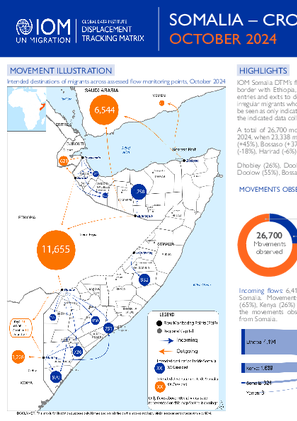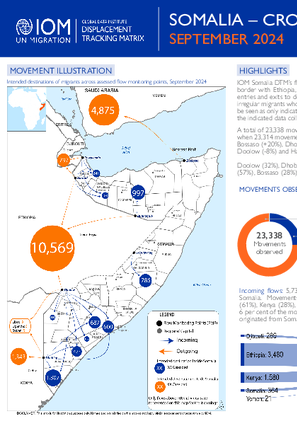-
Countries
-
Data and Analysis
-
Special Focus
-
Crisis Responses
No
This report is an update of the one published on 15 November (ETT 52.1) following armed violences since 11 November in the Metropolitan Area of Port-au-Prince (MAPAP). In total, 40,965 people were displaced as a result of this violence, including 64% to areas located in the municipality of Port-au-Prince, 25 to Delmas and 9% to Pétion-Ville (see graph below). It should be noted that these figures represent the largest mass displacements observed within the MAPAP since DTM started the implementation of the ETT (see page 2). The majority of displaced people (90%; or 37,007 individuals) took refuge in 23 sites, including 4 that already existed before these incidents and 19 that were created because of this situation. In addition, 21 sites were emptied following these incidents, their populations have in majority left for new sites (see map below and/or this interactive map).

Contact
dtmhaiti@iom.int
Language
English
Location
Haiti
Period Covered
Nov 11 2024
Nov 20 2024
Activity
- Mobility Tracking
- Event Tracking
This report is an update of the one published on 15 November (ETT 52.1) following armed violences since 11 November in the Metropolitan Area of Port-au-Prince (MAPAP). In total, 40,965 people were displaced as a result of this violence, including 64% to areas located in the municipality of Port-au-Prince, 25 to Delmas and 9% to Pétion-Ville (see graph below). It should be noted that these figures represent the largest mass displacements observed within the MAPAP since DTM started the implementation of the ETT (see page 2). The majority of displaced people (90%; or 37,007 individuals) took refuge in 23 sites, including 4 that already existed before these incidents and 19 that were created because of this situation. In addition, 21 sites were emptied following these incidents, their populations have in majority left for new sites (see map below and/or this interactive map).
The GRANIT was conceived in 2021 in Dakar at the initiative of OCHA, IOM and REACH with the support of the Regional Sectoral Groups, UN agencies and NGOs. GRANIT seeks to create a forum of technical experts and information managers to pave the way for a regional, holistic and cross-sectoral analytical approach to inform the crisis preparedness and response phases. The aim of the monitoring tool is to track developments in the context in the target countries, using a multi-hazard approach. To this end, 15 indicators have been selected by the regional group of experts in emergency preparedness and response and GRANIT members. This report presents the evolution of the situation in Benin, Côte d'Ivoire, Ghana and Togo, as of 30 September 2024.

Contact
DTM Chad, dtmtchad@iom.int
Language
English
Location
Chad
Period Covered
Oct 26 2024
Nov 08 2024
Activity
- Mobility Tracking
An estimated 910,000 people have crossed into Chad since the onset of the crisis in Sudan, of which 209,153 are Chadian returnees as of beginning of November 2024. IOM expects this number to rise to 240,000 through to December 2024 due to ongoing conflict and food insecurity in Darfur.

Contact
dtmlebanon@iom.int
Language
English
Location
Lebanon
Period Covered
Nov 18 2024
Nov 20 2024
Activity
- Mobility Tracking
- Baseline Assessment
Since October 8 there has been an increase in cross-border incidents between Israel and Lebanon, resulting in the displacement of people both within the South and elsewhere within the country. Since October 10, the Displacement Tracking Matrix (DTM) has been conducting the daily monitoring of population movements. The objective of the exercise is to inform preparedness and response planning.

Contact
DTM Somalia, IOMSomaliaDTM@iom.int
Language
English
Location
Somalia
Period Covered
Oct 01 2024
Oct 31 2024
Activity
- Survey
- Flow Monitoring Survey
- Flow Monitoring
- Flow Monitoring Registry
A total of 26,700 movements were observed in October 2024, representing 14 per cent increase compared to September 2024, when 23,338 movements were observed during this period. Comparing October 2024 with September 2024, Buuhoodle (+45%), Bossaso (+37%), Cabudwaaq (+19%) and Doolow (+7%) FMPs recorded an increase in movements while Lowyacado (-18%), Harirad (-6%) and Dhobley (-1%) FMPs recorded a decrease in movements.
Dhobley (26%), Doolow (25%), and Cabudwaaq (15%) FMPs recorded the highest numbers of incoming movements, while Doolow (55%), Bossaso (33%) and Dhobley (6%) recorded the highest numbers of outgoing movements for October 2024.

Contact
DTM Somalia, IOMSomaliaDTM@iom.int
Language
English
Location
Somalia
Period Covered
Sep 01 2024
Sep 30 2024
Activity
- Survey
- Flow Monitoring Survey
- Flow Monitoring
- Flow Monitoring Registry
A total of 23,338 movements were observed in September 2024, representing 0.1 per cent increase compared to August 2024, when 23,314 movements were observed during this period. Comparing September 2024 with August 2024, Buuhoodle (+32%), Bossaso (+20%), Dhobley (+5%) and Lowyacado (+1%) FMPs recorded an increase in movements while Cabudwaaq (-25%), Doolow (-8%) and Harirad (-5%) FMPs recorded a decrease in movements.
Doolow (32%), Dhobley (28%), and Bossaso (17%) FMPs recorded the highest numbers of incoming movements, while Doolow (57%), Bossaso (28%) and Dhobley (8%) recorded the highest numbers of outgoing movements for September 2024.

Contact
DTMAfghanistan@iom.int
Language
English
Location
Afghanistan
Period Covered
Nov 10 2024
Nov 16 2024
Activity
- Survey
- Flow Monitoring Survey
- Flow Monitoring
DTM Flow Monitoring, conducted by IOM Afghanistan, is designed to provide insights into the mobility patterns at Afghanistan’s border points with the Islamic Republic of Iran and Pakistan. This activity involves two interlinked exercises: Flow Monitoring Counting (FMC), which monitors the number of movements across the border, and Flow Monitoring Surveys (FMS), which collect data on the profiles of randomly selected Afghan nationals crossing the border including documentation held, reasons for travel, and the intended period of stay/ travel. It is important to note that DTM collects information on total movements at a given border point, not the number of unique individuals entering or leaving the country. As a result, if one individual both left and re-entered Afghanistan during the reporting period, this would count as one outflow movement and one inflow movement. Movements can be attributed to a wide variety of reasons, including returnees coming back to Afghanistan after living abroad, people visiting family, deportees, those travelling for economic reasons, medical patients, students, or Afghans moving abroad for different reasons. Circular movements, which include those who frequently and regularly travel back and forth across the border for trade and other reasons, are also common. This monitoring offers a clear picture of population movements in and out of the country.
DTM FM is operational at four main crossing points (connected to Afghanistan’s National Highway) as well as six other crossing points with Islamic Republic of Iran and Pakistan. This weekly snapshot combines information from the FM activity and various IOM sources related to cross-border movement. For a detailed explanation of the methodology used in gathering this data, the report directs readers to the section titled “IOM INFLOW DATA” on the last page.

Contact
DTMMozambique@iom.int
Language
English
Location
Mozambique
Period Covered
Nov 17 2024
Nov 18 2024
Activity
- Mobility Tracking
- Event Tracking
Between 17 and 18 November 2024, recent attacks and the pervasive fear of further violence by Non-State Armed Groups (NSAGs) in Ancuabe district have triggered the displacement of approximately 1,854 individuals, representing 393 families. This sudden movement underscores the volatile security situation in Cabo Delgado, where civilians continue to bear the brunt of ongoing instability. According to the Key Informants’ responses, 50% of the individuals displaced mentioned food as the immediate humanitarian need followed by shelter (31%), and essential Non-Food Items (19%), as families struggle to cope with the trauma and disruption caused by these events.

Contact
DTM Ukraine, dtmukraine@iom.int
Language
English
Location
Ukraine
Snapshot Date
Aug 12 2024
Activity
- Other
Since the full-scale invasion of Ukraine in February 2022, the country has confronted profound economic disruptions alongside widespread displacement. To date, 3.7 million people remain internally displaced (IDPs), while 4.4 million people who had been displaced have since returned to their primary places of residence. According to the World Bank, more than 9 million people in Ukraine are estimated to be living in poverty, an increase of 1.8 million people since February 2022. The pace of recovery in Ukraine is also projected to slow to 3.2 per cent in 2024 from 4.8 per cent in 2023, due to a smaller harvest and a persistent labour shortage. With millions seeking safety and stability, often while remaining in displacement, the challenges of maintaining livelihoods and accessing social protection are paramount, necessitating focused interventions to mitigate economic hardships.
This report provides a snapshot of livelihoods in Ukraine, focusing on income, social assistance and coping strategies, as well as exploring the relationship between income levels and displacement. Additionally, to better support evidence-based programming, the brief analyses the relationship between income and estimated eligibility for Multi-Purpose Cash Assistance (MPCA). The analysis foregrounds the age and gender dimensions, highlighting that priorities, capacities and needs are unique to different individuals and notably vary based on the intersection of vulnerabilities, exclusion and discrimination.
Pagination
- Page 1
- Next page


